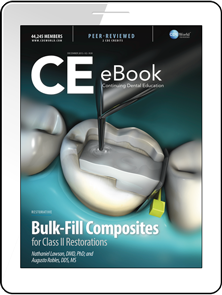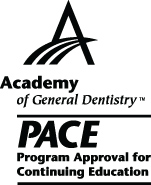CDEWorld > eBooks > Bulk-Fill Composites for Class II Restorations


ADA CERP is a service of the American Dental Association to assist dental professionals in identifying quality providers of continuing dental education. ADA CERP does not approve or endorse individual courses or instructors, nor does it imply acceptance of credit house by boards of dentistry. Concerns or complaints about a CE provider may be directed to the provider or to ADA CERP at www.ada.org/cerp/

Approved PACE Program Provider. FAGD/MAGD credit. Approval does not imply acceptance by a state or provincial board of dentistry, or AGD endorsement. 1/1/2023 to 12/31/2028. ID # 209722.
eBook
Released: Monday, December 28, 2015
Expires: Friday, August 31, 2018
Bulk-Fill Composites for Class II Restorations
By Nathaniel Lawson, DMD, PhD; and Augusto Robles, DDS, MS
Commercial Supporter: VOCO America
The layering technique has been advocated for posterior composites to reduce polymerization shrinkage and allow adequate depth of cure. Recently, bulk-fill composites have been introduced that allow the practitioner to place composites in increments of 4 mm. Initial testing of these materials has determined that bulk-fill composites can obtain a depth of cure and shrinkage stress at 4 mm comparable with a conventional composite with a 2-mm increment. Bulk-fill composites were first introduced in a flowable consistency and have since been formulated with a high-viscosity universal consistency. Some flowable materials do not exhibit sufficient wear resistance and must be covered with a more highly filled composite. The technique for placing these materials is slightly different than for conventional composites, as the layers of composites are not condensed against the matrix, and therefore, a contoured matrix, ring, and sufficient wedging are recommended. Flowable bulk-fill materials are well-suited for Class II boxes and build-ups around posts.
LEARNING OBJECTIVES:
-
Explain the importance of shrinkage stress and depth of cure in the bulk-fill technique.
-
Understand how bulk-fill composites reduce shrinkage stress and increase depth of cure.
-
Describe the types, clinical applications, and limitations of bulk-fill composites.
About the Authors
Nathaniel Lawson, DMD, PhD, is an assistant professor in the division of biomaterials at the University of Alabama at Birmingham (UAB). He started his education as a biomedical engineering student at Tulane University. He completed his DMD at the UAB School of Dentistry and his MS and PhD in the department of miomedical engineering at UAB. Following graduation, he worked in private practice for 1.5 years in Alabama and Illinois. Dr. Lawson is passionate about testing new materials and techniques in the laboratory. His main research focus involves testing the strength, color, wear, roughness and bond strength of ceramics, composites, cements, impression materials, and adhesives.
Augusto Robles, DDS, is an Assistant Professor and Director of Operative Dentistry at the University of Alabama, Birmingham, School of Dentistry. A member of the American Academy of Cosmetic Dentistry, he maintains a private practice in Birmingham, Alabama.
Download FREE eBook now!

